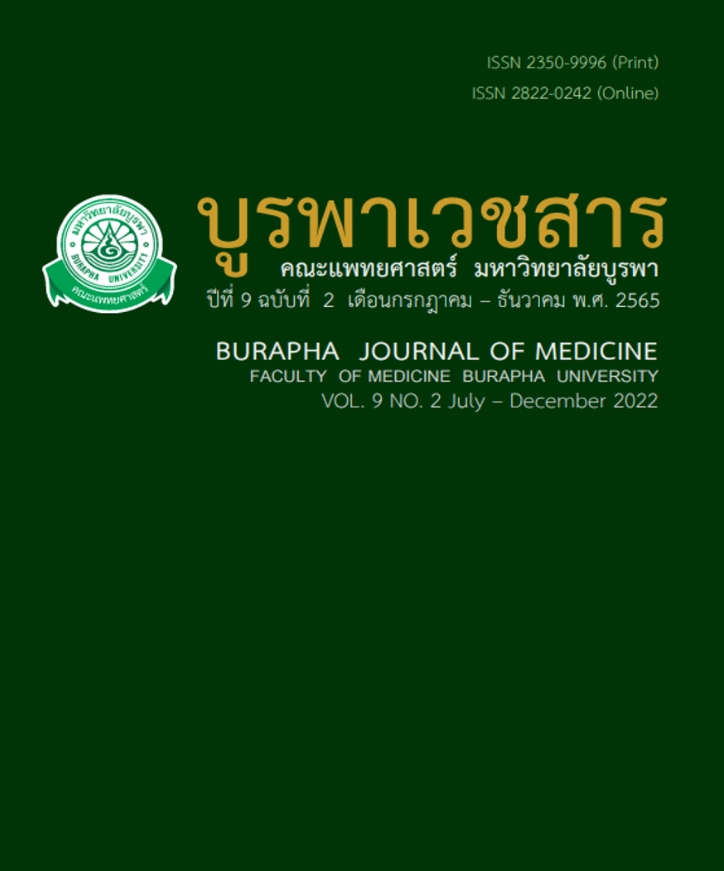ความสัมพันธ์ระหว่างความชำนาญในการใช้มือกับการทรงท่าของลำตัวในกลุ่มเด็กสมองพิการในช่วงประถมศึกษา
คำสำคัญ:
ภาวะสมองพิการ, การควบคุมการทรงท่าของลำตัว, ความชำนาญในการใช้มือบทคัดย่อ
บทนำ ภาวะสมองพิการเป็นกลุ่มอาการที่มีความผิดปกติของพัฒนาการด้านการเคลื่อนไหว เป็นผลมาจากสมองส่วนที่ควบคุมการเคลื่อนไหวนั้นเกิดความผิดปกติหรือถูกทำลายในขณะที่สมองอยู่ระหว่างการเจริญเติบโต ทำให้พัฒนาการด้านการเคลื่อนไหวและการทรงท่าเกิดความบกพร่อง ส่งผลให้เกิดปัญหาต่อการควบคุมการทรงท่าของลำตัวและความชำนาญในการใช้มือ
วัตถุประสงค์ เพื่อศึกษาความสัมพันธ์ระหว่างความชำนาญในการใช้มือกับการทรงท่าของลำตัวในกลุ่มเด็กสมองพิการ ในช่วงประถมศึกษา
วิธีการศึกษา เด็กสมองพิการ จำนวน 10 คน อายุ 7-12 ปี ที่มีระดับความสามารถด้านการเคลื่อนไหว และความสามารถในการใช้มืออยู่ที่ระดับ I ถึงระดับ III ทำการทดสอบด้วยแบบประเมิน Trunk Control Measurement Scale (TCMS) สำหรับดูการควบคุมการทรงท่าของลำตัว แบบประเมิน Block and Box Test (BBT) กับแบบประเมิน Nine Hole Peg Test (NHPT) สำหรับดูความชำนาญในการใช้มือ และหาความสัมพันธ์โดยใช้สถิติ Spearman’s correlation
ผลการศึกษา พบว่า NHPT ข้างถนัดและไม่ถนัด และ BBT ข้างถนัดและไม่ถนัด มีความสัมพันธ์กับ TCMS ทางบวกในระดับสูง (r=0.8 (p=0.002), r= 0.6(p=0.045), r= 0.7(p=0.014), r= 0.8(p=0.004) ตามลำดับ)
สรุป ความชำนาญในการใช้มือกับการควบคุมการทรงท่าของลำตัวมีความสัมพันธ์กันในระดับสูง
คำสำคัญ: ภาวะสมองพิการ การควบคุมการทรงท่าของลำตัว ความชำนาญในการใช้มือ
เอกสารอ้างอิง
Arner M, Eliasson A, Nicklasson S, Sommerstein K, Hägglund G. Hand function in cerebral palsy. Report of 367 children in a population-based longitudinal health care program. J Hand Surg. 2008; 33: 1337-47.
Hsieh C, Sheu C, Hsueh I, Wang C. Trunk control as an early predictor of comprehensive activities of daily living function in stroke patients. Stroke. 2002; 33: 2626-30.
Shumway CA, Woollacott MH. Motor control: translating research into clinical practice. 5th ed. Philadelphia: Wolters Kluwer; 2017.
Bleyenheuft Y, Thonnard JL. Hand functioning in children with cerebral palsy. Front Neurol. 2014; 5: 48.
Golubovic S, Slavkovic S. Manual ability and manual dexterity in children with cerebral palsy. Hippokratia. 2014; 18: 310–4.
Heyrman L, Molenaers G, Desloovere K, Verheyden G, De Cat J, Monbaliu E, Feys H. A clinical tool to measure trunk control in children with cerebral palsy: the trunk control measurement scale. Res Dev Disabil 2011; 32: 2624-35.
Jacob-Lloyd H, Dunn O, Brain N, Lamb S. Effective measurement of the functional progress of stroke clients. Br J Occup Ther. 2005; 68: 253-9.
Smith Y, Hong E, Presson C. Normative and validation studies of the nine-hole peg test with children. Percept Mot Skills. 2000; 90: 823-43.
Sunderland A, Tinson D, Bradley L, Hewer R. Arm function after stroke. An evaluation of grip strength as a measure of recovery and a prognostic indicator. J Neurol Neurosurg Psychiatry. 1989; 52: 1267-72.
Mathiowetz V, Volland G, Kashman N, Weber K. Adult norms for the box and block test of manual dexterity. Am J Occup Ther. 1985; 39: 386-91.
Cohen J. A power primer. Psychol Bull. 1992; 112: 155-9.
Muezzinoglu O, Karayazgan S, Mahmut Z, Hatice Y, Burcu A, Akel S. The relation between trunk control and upper extremity functions. European Academy of childhood Disability 27th Annual meeting, 27-30 May 2015, Copenhagen, Denmark, 54.
Yildiz A, Yildiz R, Elbasan B. Trunk control in children with cerebral palsy and its association with upper extremity functions. J Dev Phys Disabil. 2018; 30: 669-76.
Angelin AC, Sposito AM, Pfeifer L. Influence of functional mobility and manual function on play in preschool children with cerebral palsy. Hong Kong J Occup Ther. 2018; 3: 46–53.
Eliasson AC, Sundholm LK, Rösblad B, Beckung E, Arner M, Ohrvall AM, Rosenbaum P. The manual ability classification system (MACS) for children with cerebral palsy: Scale development and evidence of validity and reliability. Dev Med Child Neurol. 2006; 48: 549–54.
Heyrman L, Desloovere K, Molenaers G, Verheyden G, Klingels K, Monbaliu E, et al. Clinical characteristics of impaired trunk control in children with spastic cerebral palsy. Res Dev Disabil. 2013; 34: 327-34.
To T, Gadarette SM, Liu Y. Biological, social, and environmental correlates of preschool development. Child Care Health Dev. 2001; 27: 187–200.
Frankerburg WK, Dodds J, Archer P. The Denver II: A major revision & restandardization of the Denver developmental screening test. Pediatrics. 1992; 89: 91–7.
Rule AC, Stewart RA. Effects of practical life materials on kindergartners’ fine motor skills. Early Child Educ J. 2002; 30: 9–13.
Suggate S, Stoeger H, Pufke E. Relations between playing activities and fine motor development. Early Child Dev Care. 2016; 187: 1297-310.
Rosenbaum P, Paneth N, Leviton A, Goldstein M, Bax M, Damiano D, et al. A report: the definition and classification of cerebral palsy April 2006. Dev Med Child Neurol Suppl. 2007; 49: 8-14.
Bertenthal B, Hofsten C. Eye, Head and Trunk Control: The Foundation for manual development. Neurosci Biobehav Rev. 1998; 22: 515-20.
Heyrman L, Desloovere K, Molenaers G, Verheyden G, Klingels K, Monbaliu E, et al. Clinical characteristics of impaired trunk control in children with spastic cerebral palsy. Res Dev Disabil. 2013; 34: 327-34.
Genthon N, Rougier P. Does the Capacity to appropriately stabilize trunk movements facilitate the control of upright standing? Mot Contr. 2006; 10: 232-43.
Soechting J. Effect of target size on spatial and temporal characteristics of a pointing movement in man. Exp Brain Res. 1984; 54: 121-32.
Sommerville J, Woodward A, Needham A. Action experience alters 3-month-old infants' perception of others' actions. Cognition. 2005; 96: B1-B11.
Soska K, Adolph K, Johnson S. Systems in development: Motor skill acquisition facilitates three-dimensional object completion. Eur J Dev Psychol. 2010; 46: 129-38.
ดาวน์โหลด
เผยแพร่แล้ว
รูปแบบการอ้างอิง
ฉบับ
ประเภทบทความ
สัญญาอนุญาต
ลิขสิทธิ์ (c) 2022 บูรพาเวชสาร

อนุญาตภายใต้เงื่อนไข Creative Commons Attribution-NonCommercial-NoDerivatives 4.0 International License.



